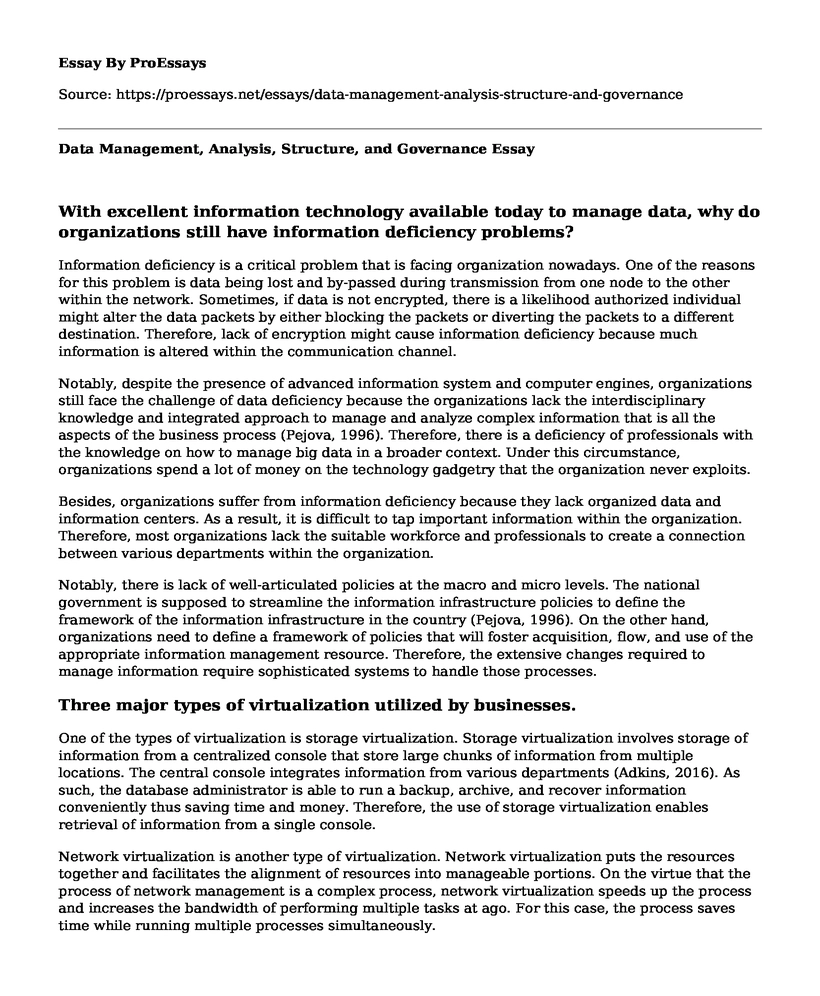With excellent information technology available today to manage data, why do organizations still have information deficiency problems?
Information deficiency is a critical problem that is facing organization nowadays. One of the reasons for this problem is data being lost and by-passed during transmission from one node to the other within the network. Sometimes, if data is not encrypted, there is a likelihood authorized individual might alter the data packets by either blocking the packets or diverting the packets to a different destination. Therefore, lack of encryption might cause information deficiency because much information is altered within the communication channel.
Notably, despite the presence of advanced information system and computer engines, organizations still face the challenge of data deficiency because the organizations lack the interdisciplinary knowledge and integrated approach to manage and analyze complex information that is all the aspects of the business process (Pejova, 1996). Therefore, there is a deficiency of professionals with the knowledge on how to manage big data in a broader context. Under this circumstance, organizations spend a lot of money on the technology gadgetry that the organization never exploits.
Besides, organizations suffer from information deficiency because they lack organized data and information centers. As a result, it is difficult to tap important information within the organization. Therefore, most organizations lack the suitable workforce and professionals to create a connection between various departments within the organization.
Notably, there is lack of well-articulated policies at the macro and micro levels. The national government is supposed to streamline the information infrastructure policies to define the framework of the information infrastructure in the country (Pejova, 1996). On the other hand, organizations need to define a framework of policies that will foster acquisition, flow, and use of the appropriate information management resource. Therefore, the extensive changes required to manage information require sophisticated systems to handle those processes.
Three major types of virtualization utilized by businesses.
One of the types of virtualization is storage virtualization. Storage virtualization involves storage of information from a centralized console that store large chunks of information from multiple locations. The central console integrates information from various departments (Adkins, 2016). As such, the database administrator is able to run a backup, archive, and recover information conveniently thus saving time and money. Therefore, the use of storage virtualization enables retrieval of information from a single console.
Network virtualization is another type of virtualization. Network virtualization puts the resources together and facilitates the alignment of resources into manageable portions. On the virtue that the process of network management is a complex process, network virtualization speeds up the process and increases the bandwidth of performing multiple tasks at ago. For this case, the process saves time while running multiple processes simultaneously.
Lastly, there is hardware virtualization. Hardware virtualization is a computer environment that is different from the actual software environment that the software is running the system. Hardware virtualization comprises of computer components that emulate the real computer hardware. The virtual hardware consolidates various multiple physical servers, allowing the company to control information from a single central server (Adkins, 2016). A hardware virtualization is simply a computing software that abstracts computing resources.
Describe at least three functions that a Database Management System (DBMS) performs to help create an accurate and consistent view of data throughout an enterprise.
The Database Management System performs various functions to foster data integrity and consistency in a database. One of the functions is data dictionary management. The data dictionary contains the definitions of data and their relationship with the metadata. Therefore, the DBMS uses this function to locate the various data components, structures, and relationship. The data dictionary is often hidden from the user. Only the administrator and the programmer can access the data dictionary. As such, the data dictionary offers user abstraction, thus making things easier for the user to access the database. Therefore, this function omits the structural and data dependency to make the system user-friendly.
Besides, the DBMS provides data security. The DBMS sets security control features that determine the privileges of various individuals accessing the database. In this case, the users are assigned the username and the password sometimes through biometric authentication. Furthermore, the DBMS sets restrictions on the data a user can access to the database by assigning privileges to the users.
Another critical function of DBMS is data storage management. The DBMS facilitates the storage of data, and other functions such as validation of rules, screen definition, report definitions, data entry forms, and structures that handle video and picture formats. As such, the users are not required to know how data is manipulated or stores in the database.
The DBMS checks on data redundancy as well as facilitating database communication. The DBMS checks of recurring data in the database. Redundancy hinders efficiency and wastes time while interacting with the database. On the other hand, the DBMS facilitates communication in the database by providing a gateway to different users from different user environments.
References
Adkins, J. K. (2016). Progression of a Data Visualization Assignment. Information Systems Education Journal, 14(6), 20.
Pejova, Z. (1996). Information management problems and challenges in transition economies. Bulletin of the Association for Information Science and Technology, 22(4), 17-19.
Cite this page
Data Management, Analysis, Structure, and Governance. (2022, Apr 18). Retrieved from https://proessays.net/essays/data-management-analysis-structure-and-governance
If you are the original author of this essay and no longer wish to have it published on the ProEssays website, please click below to request its removal:
- Essay Sample on Programming
- Windows Server Networking Paper Example
- Essay Example on E-Business: Buying, Selling, Services, Supplies, and More
- Adverse Effects of Technology on Children
- Essay Sample on Cybersecurity Advancement
- Paper Example on Organizational Analysis: Process of Growth Appraisal and Problem Resolution
- Paper Example on Strategic Plan Analysis: Gauging Goals & Objectives Achieved







